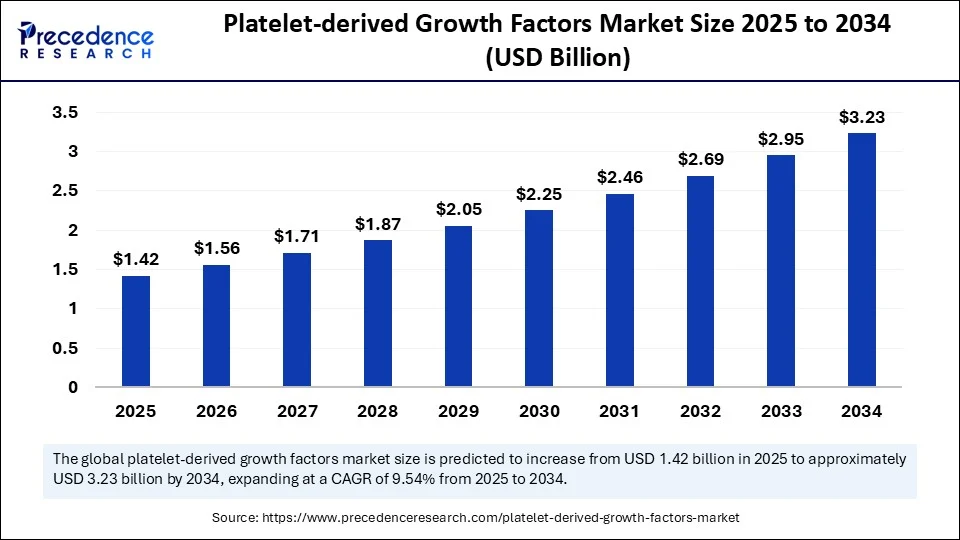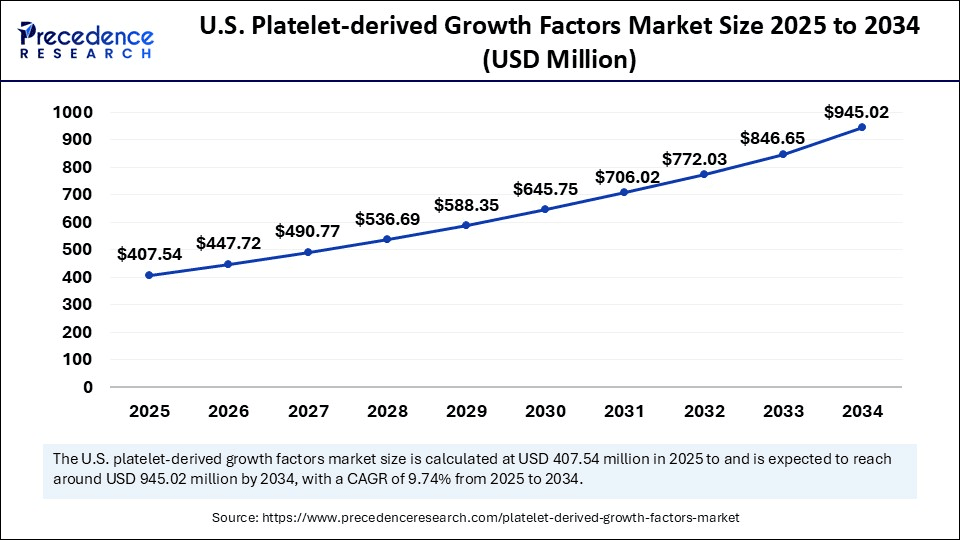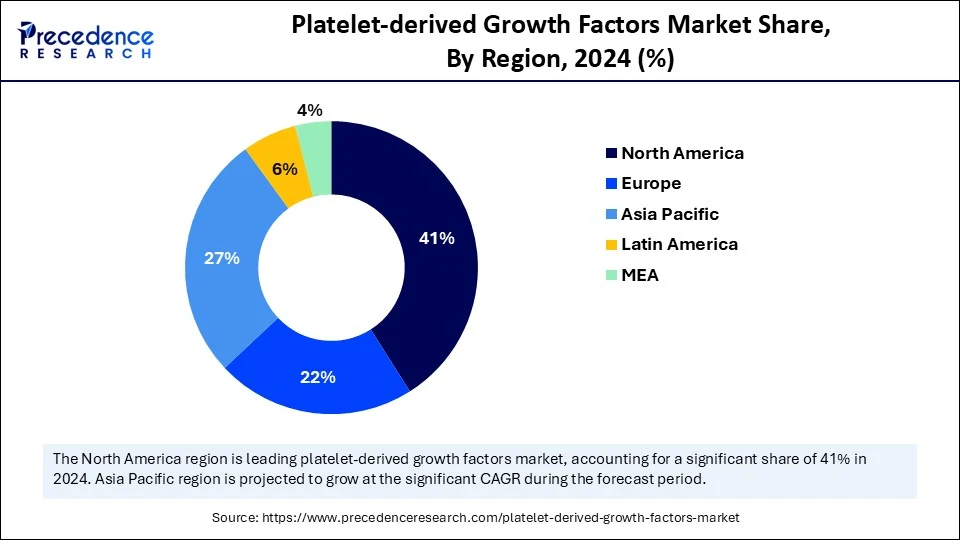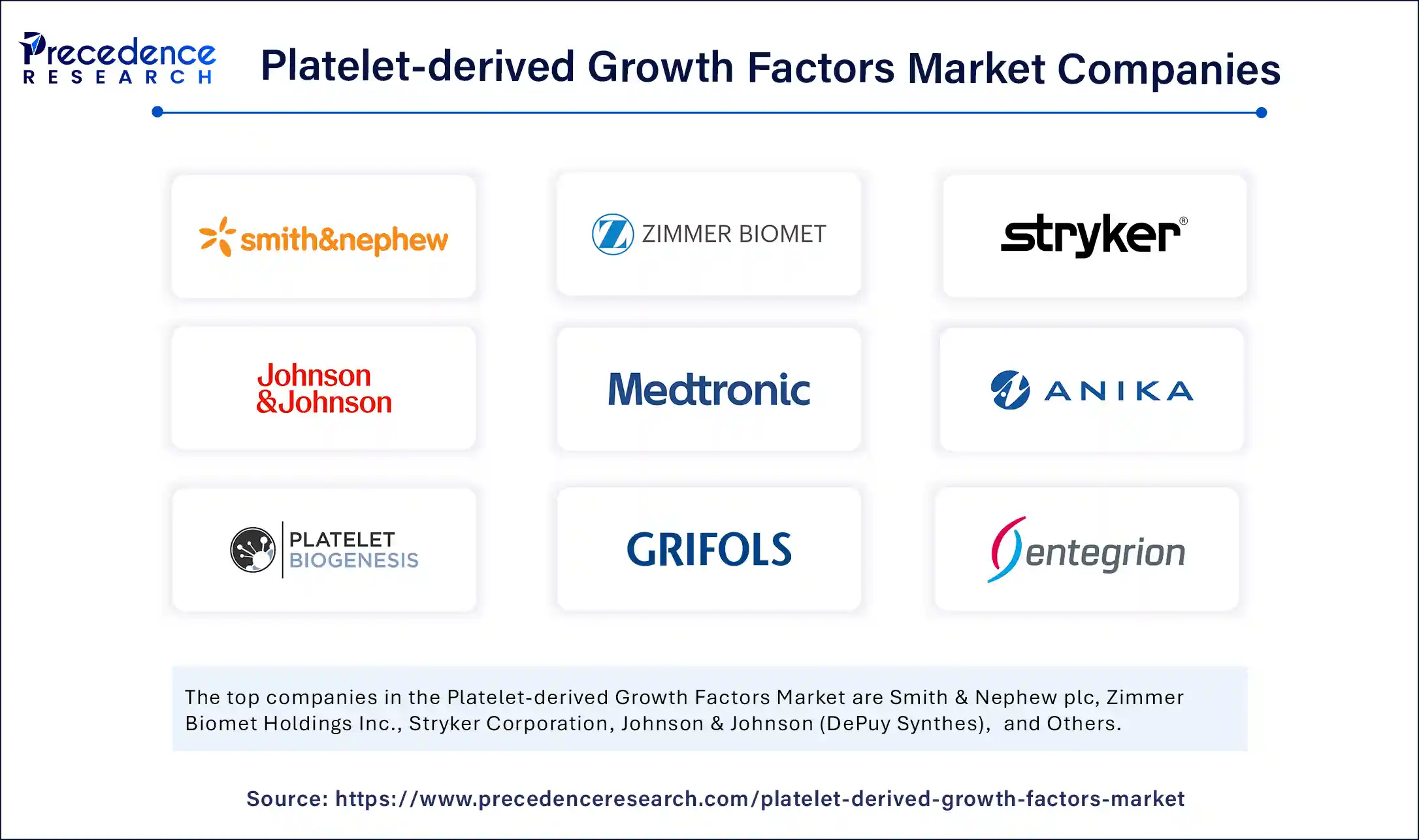List of Contents
Platelet-derived Growth Factors Market Size and Forecast 2025 to 2034
The global platelet-derived growth factors market size accounted for USD 1.3 billion in 2024 and is predicted to increase from USD 1.42 billion in 2025 to approximately USD 3.23 billion by 2034, expanding at a CAGR of 9.54% from 2025 to 2034.The growth of the platelet-derived growth factors market is driven by rising demand for regenerative medicine, advancements in wound healing therapies, and growing applications in tissue engineering and cell therapy.

Platelet-derived Growth Factors MarketKey Takeaways
- In terms of revenue, the global platelet-derived growth factors market was valued at USD 1.3 billion in 2024.
- It is projected to reach USD 3.23 billion by 2034.
- The market is expected to grow at a CAGR of 9.54% from 2025 to 2034.
- North America dominated the platelet-derived growth factors market with the largest market share of 41% in 2024.
- Asia Pacific is expected to witness the fastest growth during the forecasted years.
- By product type, the recombinant human PDGF segment held a biggest market share in 2024.
- By product type, the PDGF delivery systems segment is expected to show considerable growth over the forecast period.
- By application, the wound healing & ulcer treatment segment captured highest market in 2024.
- By application, the cosmetic & aesthetic applications segment is expected to show considerable growth over the forecast period.
- By end user, the hospitals & clinics segment contributed the highest market share in 2024.
- By end user, the specialty dermatology & aesthetic clinics segment is expected to grow at the fastest CAGR over the forecast period.
- By route of administration, the injectable segment held a significant share in 2024.
- By route of administration, the implantable/scaffold-based segment is anticipated to show considerable growth over the forecast period.
- By formulation, the gel/hydrogel formulations segment generated the major market share in 2024.
- By formulation, the others segment, especially the nanoparticle-loaded / controlled release formulations sub-segment is expected to show considerable growth in the market over the forecast period.
How is AI Integration Transforming the Platelet-derived Growth Factors Market?
Artificial Intelligence is significantly impacting the platelet-derived growth factors market, accelerating research, improving clinical outcomes, and streamlining product development. AI-powered platforms in drug discovery and development analyze vast biological datasets, identifying new PDGF signaling pathways, predicting consistent therapeutic responses, and fostering the development of new indications. AI also enhances clinical decision-making, optimizing PDGF use by analyzing real-time patient data to guide precise dosages, thus enhancing therapy. Moreover, AI-powered imaging devices enable more successful monitoring of the wound healing process.
U.S. Platelet-derived Growth Factors Market Size and Growth 2025 to 2034
The U.S. platelet-derived growth factors market size was exhibited at USD 373.10 million in 2024 and is projected to be worth around USD 945.02 million by 2034, growing at a CAGR of 9.74% from 2025 to 2034.

What Made North America the Dominant Region in the Platelet-Derived Growth Factors Market in 2024?
North America dominates the platelet-derived growth factors market by capturing the largest revenue share in 2024. This dominance is fueled by a well-developed healthcare infrastructure, a growing prevalence of chronic diseases such as diabetes and vascular issues, and a strong emphasis on regenerative medicine. The increasing incidence of non-healing wounds and post-surgery complications has led to the adoption of advanced wound care treatments, including PDGF-based therapies, among healthcare providers in North America. There is also a high awareness among both care providers and patients regarding the advantages of biologically active treatments. Furthermore, the presence of renowned research institutions and a supportive regulatory environment fosters innovation and accelerates product registration.
The U.S. is a major contributor to the market. The robust biopharmaceutical industry in the country creates a favorable environment for innovation and the commercialization of advanced regenerative medicine. Rising clinical research initiatives, supported by both government and commercial funding, have made the U.S. a key driver of PDGF discovery. The U.S. Food and Drug Administration (FDA) offers transparent regulatory pathways that facilitate the swift introduction of new treatment solutions, contributing to market growth.

What Makes Asia Pacific the Fastest-Growing Region in the Market?
Asia Pacific is expected to grow at the fastest CAGR during the forecast period, driven by improved access to healthcare and the prevalence of chronic diseases. The rising number of cases of diabetes, orthopedic injuries, and undergoing surgeries in countries like India, Japan, South Korea, and other Southeast Asian nations is increasing the demand for advanced wound treatments and regenerative products. Additionally, governments around the region have implemented policies to encourage biotechnology innovation, and regulatory bodies are streamlining approval processes to facilitate the introduction of new regenerative products, supporting market growth in the region.
China is a major player in the market. This is mainly due to the large patient population and rising rates of diabetes, cardiovascular diseases, and cancer, which are driving the demand for regenerative treatments in the country. With initiatives like the National College of Biotechnology, which invests in biopharmaceutical research, and healthcare modernization efforts such as Healthy China 2030, the Chinese government is significantly investing in the development of biologically based therapies, supporting market growth.
What Factors are Influencing the Platelet-Derived Growth Factors Market in Europe?
The market in Europe is expected to grow at a notable rate in the upcoming period, driven by its well-established healthcare infrastructure, advanced regulatory framework, and a focus on medical innovation. The region benefits from EU's support in organizing research, ensuring patent security, and fostering the development of advanced biopharmaceuticals. PDGF-derived therapies are gaining acceptance among clinicians in Europe for managing chronic wounds, post-surgery recovery, orthopedic injuries, and cosmetic surgery. Furthermore, healthcare spending is increasing, the population is aging, and the disease burden related to progressive and advanced wound care and tissue repair solutions is growing, contributing to market growth.
Germany is a significant player in the market due to its well-established biomedical research infrastructure. Numerous leading research organizations and biotechnology companies in the country are involved in the development and commercialization of PDGF-based products. German hospitals and academic centers lead clinical research studies on wound healing, orthopedics, and oncology, which strengthens the country's position in therapeutic innovation. Furthermore, government and commercial partnerships in medical innovation accelerate the translation of clinical results and the availability of new therapies in the market.
Market Overview
The platelet-derived growth factors (PDGFs) market comprises biologically active proteins and therapeutic products based on PDGF isoforms (such as PDGF-AA, -BB, -AB, -CC, and -DD), which are primarily involved in wound healing, angiogenesis, cell proliferation, and tissue regeneration. These growth factors are increasingly used in regenerative medicine, orthopedics, cosmetic surgery, chronic wound care, and oncology. The market includes recombinant PDGF-based drugs, autologous PDGF products, PDGF assays, and delivery systems.The increasing prevalence of diabetes and chronic wounds has amplified the need for effective regenerative solutions, positioning PDGF as a crucial component in wound healing treatments. The integration of PDGF with combined therapies and bioengineered skin substitutes is poised to accelerate its adoption within healthcare settings.
What Factors are Fueling the Growth of the Platelet-derived Growth Factors Market?
- Increase in Incidences of Chronic Wounds: Diabetic foot ulcers and pressure sores, common chronic wounds in diabetes patients, are increasing due to rising diabetes cases and related complications. This drives the need for effective wound healing treatments, such as PDGF, known for its cellular regenerative and tissue regeneration properties.
- Progress in Regenerative Medicine: Advanced regenerative medicine technologies, like bioengineered skin grafts and tissue scaffolds, have expanded PDGF's use in therapies. These innovations enable more targeted and effective healing, integrating PDGF into advanced care protocols, thus broadening its application across hospitals, wound care centers, and outpatient clinics.
- Investment in Cancer Research and Targeted Treatments:PDGF signaling pathways are linked to tumor growth and angiogenesis, positioning PDGFR as a potential cancer treatment target. Increased research investment has led to PDGFR inhibitors and combination therapies, boosting demand and growth for PDGF in oncology applications.
Market Scope
| Report Coverage | Details |
| Market Size by 2034 | USD 3.23 Billion |
| Market Size in 2025 | USD 1.42 Billion |
| Market Size in 2024 | USD 1.3 Billion |
| Market Growth Rate from 2025 to 2034 | CAGR of 9.54% |
| Dominating Region | North America |
| Fastest Growing Region | Asia Pacific |
| Base Year | 2024 |
| Forecast Period | 2025 to 2034 |
| Segments Covered | Product Type, End User, Route of Administration, Application, Formulation, and Region |
| Regions Covered | North America, Europe, Asia-Pacific, Latin America, and Middle East & Africa |
Market Dynamics
Drivers
Personalized Medicine and Customized PDGF Reagents
The personal medicine trend that has been on the rise is playing a key role in driving the growth of the platelet-derived growth factors market. With the further insight into genetics, molecular, and environmental factors that modulate the healing of wounds and wound-related tissue regeneration, there is a rapid shift to platelet-derived growth factors for developing personalized treatments. The basis of this customization is referred to as genomic and proteomic analyses that detect the specific signaling mechanisms and the needs of growth factors specific to each patient. Moreover, there is a recent breakthrough in creating these precise formulations in biotechnology and bioinformatics, allowing their efficient development and production, thus making them more readily available to use in clinical practice. Integration of personalized medicine that increases the effectiveness of therapy also promotes innovation and differentiation in the PDGF market.
Restraint
Stringent Regulations and High Development Costs
The key constraint affecting the platelet-derived growth factors market is the strict regulation that surrounds the process of approving and commercializing biopharmaceutical products. Strict safety, efficacy, and quality are mandated by regulatory bodies like the U.S. Food and Drug Administration (FDA) and European Medicines Agency (EMA). Such requirements extend the time needed to have a product on the market and substantially increase the level of costs for small biotech and other startups. Moreover, it is very expensive to conduct R&D in the area of PDGF formulation, manufacturing, and clinical validation.
Opportunity
Rising Demand for Chronic Wound Management
PDGF-based therapies are also on the rise as their efficacy at promoting cell growth by assisting cell proliferation, angiogenesis, and wound healing has been well established, and thus has a lower likelihood of getting wound complications like infections and amputations. With the trend shifting away from healthcare systems to provide a better quality of life to their patients and reduce long-term treatment costs, PDGF products are being incorporated into modern wound care regimens. They are particularly useful in patients with recurrent or non-healing wounds as they help reduce scars and enhance healing results. As governments and other healthcare providers focus more on reducing the burden of chronic wounds, the pressure on biologically active target-specific therapies like PDGF will further increase.
Product Type Insights
How Does the Recombinant Human PDGF Segment Lead the Platelet-Derived Growth Factors Market?
The recombinant human PDGF segment led the platelet-derived growth factors market while holding the largest revenue share in 2024. Recombinant PDGF offers high purity, consistency, and safety, making it ideal for therapeutic procedures in wound healing, tissue regeneration, and body reconstruction. Manufactured under defined conditions using advanced biotechnology, recombinant PDGF ensures batch-to-batch consistency, critical for controlled clinical responses and adherence to high regulatory standards. It presents a lower risk of immunogenic reactions compared to naturally derived PDGF, making it advantageous in sensitive therapeutic applications. These qualities have led to its widespread use in hospitals, outpatient centers, and research facilities.
The PDGF delivery systems segment is expected to grow at a significant CAGR over the forecast period. The importance of proper delivery lies in the maximization of the therapeutic effects of PDGF through making the drug sustain release, selective to the target, and degrade less. Conventional application methods often result in rapid disintegration or inefficient absorption, limiting the clinical effectiveness of PDGF treatment. Advanced delivery systems optimize PDGF bioavailability, reduce administration frequency, and lower treatment costs, making treatments more affordable, accessible, and patient-friendly. The application of smart materials, responsive to environmental stimuli such as pH, temperature, or inflammation, further enhances these delivery technologies.
Application Insights
Why Did the Wound Healing & Ulcer Treatment Segment Contribute the Most Revenue in 2024?
The wound healing & ulcer treatment segment contributed the most revenue share of the platelet-derived growth factors market in 2024. The increasing prevalence of conditions like diabetes, vascular diseases, and pressure ulcers, particularly among the aging population, has significantly increased the demand for efficient and rapid wound care products. PDGF's ability to induce rapid proliferation, angiogenesis, and extracellular matrix synthesis makes it a crucial therapeutic agent for treating complex and non-healing wounds. The effective integration of PDGF into advanced wound management products, such as bioactive dressings, engineered skin grafts, and topical gels, has revolutionized wound healing by optimizing tissue regeneration and accelerating healing times. Growing awareness among medical professionals regarding the benefits of PDGF-based therapies and the adoption of evidence-based treatment plans have further contributed to the growth of this segment.
The cosmetic & aesthetic applications segment is expected to grow at the highest CAGR in the upcoming period. This is mainly due to the ability of PDGFs to enhance collagen production, stimulate rejuvenation, and improve skin texture, making it a valuable ingredient in aesthetic dermatology. Its use in skin rejuvenation treatments, microneedling serums, PRP treatments, and dermal fillers is rapidly gaining popularity among consumers seeking natural and lasting cosmetic effects. Dermatologists and cosmetic surgeons are increasingly using PDGF during the post-procedure healing phase to accelerate healing, reduce inflammation, and improve overall treatment outcomes. The development of advanced delivery platforms, including nano-carriers and controlled-release topical solutions, will further expand PDGF's role in aesthetic products.
End User Insights
What Made Hospitals & Clinics the Dominant Segment in the Platelet-Derived Growth Factors Market in 2024?
The hospitals & clinics segment dominated the market, accounting for the largest revenue share in 2024. DGF-based therapies are highly adopted in these settings in managing complex and chronic wounds, surgical recoveries, orthopedic injuries, and reconstructive procedures, where hospitals play a crucial role. The multidisciplinary team and specialized wound care units in these settings enable efficient and precise administration of PDGF products, leading to improved patient outcomes. Hospitals are key contributors to clinical research and are early adopters of biopharmaceutical innovations, such as new PDGF formulations. Additionally, hospitals have established procurement and reimbursement systems that facilitate access to costly regenerative treatments.
The specialty dermatology & aesthetic clinics segment is expected to grow at a significant CAGR over the forecast period. These clinics offer specialized treatments and services in skin rejuvenation, hair regrowth, scar revisions, and anti-aging, where the regenerative effects of PDGF are highly beneficial. These procedures boost collagen production, accelerate healing, and enhance aesthetic appeal, attracting patients seeking natural results. Clinics also offer a more personalized treatment experience and have lower overhead costs compared to hospitals, which is valued by patients seeking convenience and consistency in care. Furthermore, the growing middle-income population, increased aesthetic awareness, and rising disposable incomes in emerging economies are driving the demand for high-value aesthetic services, contributing to segmental growth.
Route of Administration Insights
Why Did the Injectable Segment Contribute the Most Revenue in 2024?
The injectable segment contributed the largest revenue share in 2024. This is primarily due to its ability to provide a direct and localized method of administering PDGF to specific treatment areas, making it useful in treating complex wounds, surgical healing sites, and orthopedic injuries. Injectables ensure accurate dosage and localized efficacy, enhancing healing effects while minimizing systemic side effects. Clinicians favor injectable PDGF in various settings, including hospitals, clinics, and outpatient care, due to ease of administration and quicker patient response. Furthermore, PDGF injectables are widely used in autologous platelet-rich plasma procedures and cosmetic applications, such as microneedling and dermal fillers, where precision and bioavailability are critical.
The implantable / scaffold-based segment is expected to grow at the fastest rate in the platelet-derived growth factors market. These scaffolds, typically made of biocompatible materials like hydrogels, biodegradable polymers, or collagen matrices, support and stimulate tissue healing and regeneration by releasing PDGF, which triggers cellular effects. They are particularly beneficial in complex surgeries, bone grafting, and reconstructive procedures where traditional methods may be inadequate. The advancement of biomaterials and 3D printing technology further improves the precision, efficacy, and versatility of PDGF-infused scaffolds, expanding their use across various medical fields. The trend towards patient-specific and site-specific treatments drives the growth of this segment, representing a key area of innovation and investment in the PDGF market.
Formulation Insights
How Does the Gel/Hydrogel Formulations Segment Dominate the Platelet-Derived Growth Factors Market in 2024?
The gel/hydrogel formulations segment dominated the platelet-derived growth factors market while holding the largest revenue share in 2024. These formulations provide an ideal moist environment for wound healing, along with the ability to deliver PDGF locally and sustainably. Gel and hydrogel formulations also reduce systemic side effects and enhance therapeutic effectiveness by potentially increasing PDGF stability and bioavailability. They are compatible with dressings, skin grafts, or bioengineered tissue products, offering flexibility in various clinical settings. The growing adoption in cosmetic and aesthetic applications with gel-based regenerative products also bolsters segment growth.
The nanoparticle-loaded / controlled release formulations segment is expected to grow at a significant CAGR over the forecast period. These advanced carrier systems aim to stabilize PDGF, protect it from degradation, and release it in a controlled, site-specific, and gradual manner. This targeted approach reduces the number of doses, maximizes treatment efficacy, and is particularly beneficial in chronic wound healing, orthopedic trauma repair, and tissue-deficient areas requiring prolonged regenerative activity. Carriers like liposomes, polymeric nanoparticles, and nanospheres, using the nanoparticle (NP) system, enable encapsulation or gradual diffusion of PDGF within the cellular environment, enhancing contact with surrounding tissues and boosting the wound healing process. As regenerative solutions become smarter, more responsive, and less invasive, controlled release formulations are gaining significant attention in product innovation.
Platelet-derived Growth Factors Market Companies

- Smith & Nephew plc
- Zimmer Biomet Holdings Inc.
- Stryker Corporation
- Johnson & Johnson (DePuy Synthes)
- Medtronic plc
- Anika Therapeutics
- BioD LLC (part of Integra LifeSciences)
- Platelet BioGenesis
- Grifols S.A.
- Entegrion Inc.
- Thermo Fisher Scientific Inc.
- R&D Systems (Bio-Techne)
- BioWorks, Inc.
- Revmedx Inc.
- Orthocell Ltd.
- EmCyte Corporation
- Regen Lab SA
- APEX Biologix
- Terumo BCT
- TBF Genie
Recent Developments
- In June 2025, Rion Aesthetics received FDA clearance to conduct a Phase 1 investigator-initiated study of its Purified Exosome ProductTM (PEP(TM)), a lyophilized powder derived from human platelets that was to be injected into the dermis to achieve regenerative aesthetics. (Source: https://www.businesswire.com)
- In April 2025, PL BioScience GmbH introduced ELAREM Ultimate-FD PLUS, the 1st gamma-sterilized GMP-grade Human Platelet Lysate produced in Germany to meet the need for virus-inactivated, xeno-free cell culture supplements in the use of regenerative medicines. (Source: https://www.biospace.com)
- In March 2025, Lynch Regenerative Medicine, LLC., (LRM) acquired exclusive rights to REGRANEX gel and recombinant purified platelet-derived growth factor (PDGF) from Smith & Nephew, Inc., for use in skin rejuvenation and regeneration as well as other soft tissue wound healing and tissue regeneration applications.
(Source: https://www.businesswire.com)
Segments Covered in the Report
By Product Type
- Recombinant Human PDGF (rhPDGF)
- Autologous Platelet-Derived Growth Factors (from PRP or PRF)
- PDGF Isoforms (AA, AB, BB, CC, DD)
- PDGF Assays & Detection Kits
- PDGF Delivery Systems (e.g., hydrogels, microspheres)
By Application
- Wound Healing & Ulcer Treatment
- Orthopedic & Sports Injuries
- Cosmetic & Aesthetic Applications
- Cardiovascular Repair
- Periodontal Regeneration
- Oncology (Targeted Therapy, Diagnostics)
- Others (e.g., neurodegeneration, liver regeneration)
By End User
- Hospitals & Clinics
- Research Institutes
- Biopharmaceutical Companies
- Ambulatory Surgical Centers
- Specialty Dermatology & Aesthetic Clinics
- Others
By Route of Administration
- Topical
- Injectable
- Implantable / Scaffold-Based
- Oral / Systemic (limited use)
By Formulation
- Liquid Formulations
- Gel / Hydrogel Formulations
- Powder / Lyophilized Formulations
- Others (e.g., nanoparticle-loaded PDGF)
By Region
- North America
- Europe
- Asia Pacific
- Latin America
- Middle East & Africa (MEA)
For inquiries regarding discounts, bulk purchases, or customization requests, please contact us at sales@precedenceresearch.com
Frequently Asked Questions
Ask For Sample
No cookie-cutter, only authentic analysis – take the 1st step to become a Precedence Research client